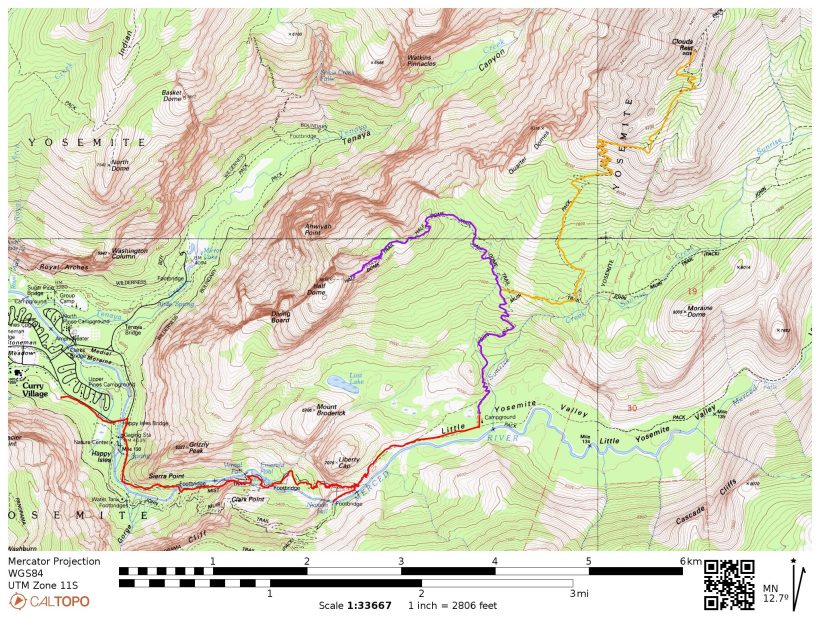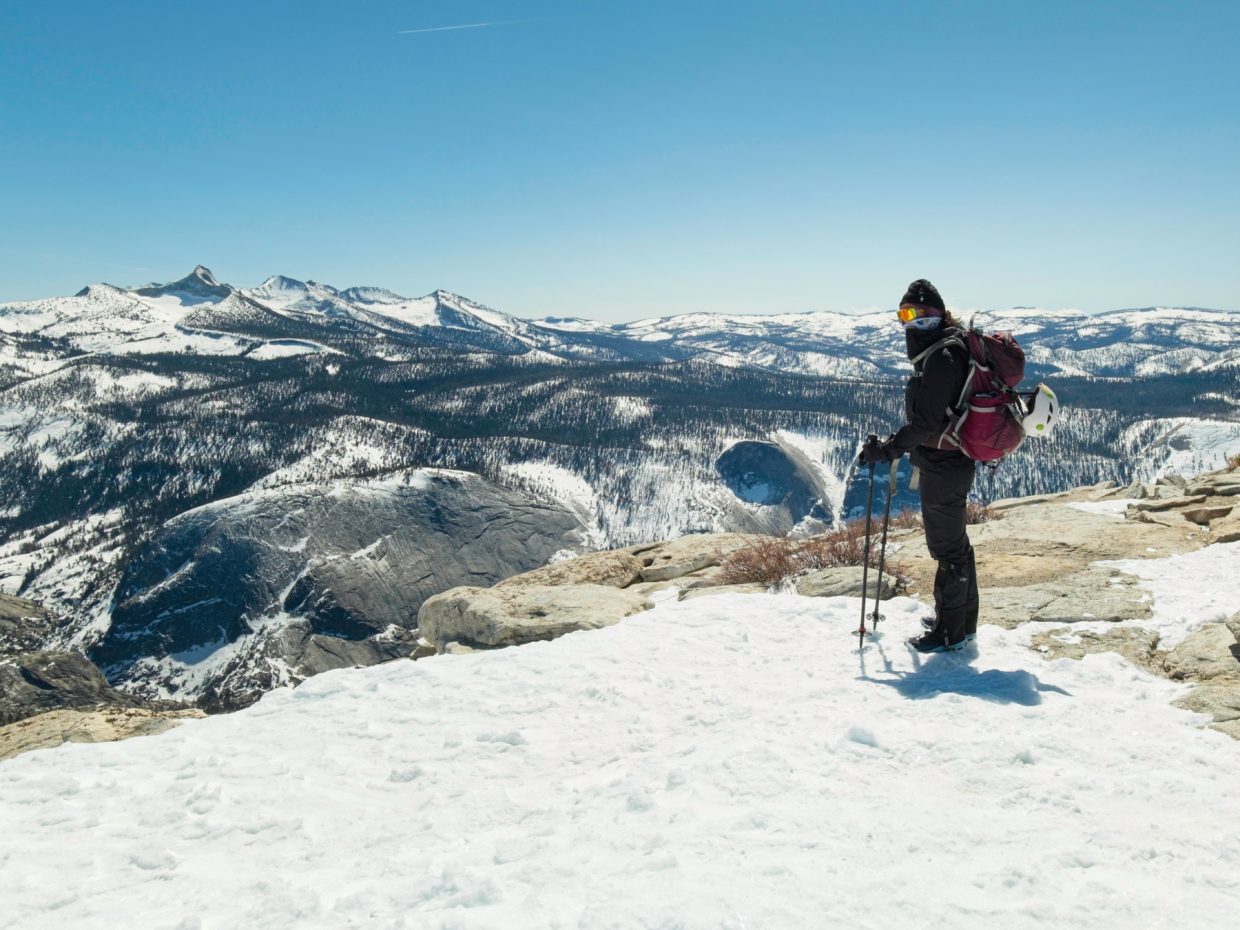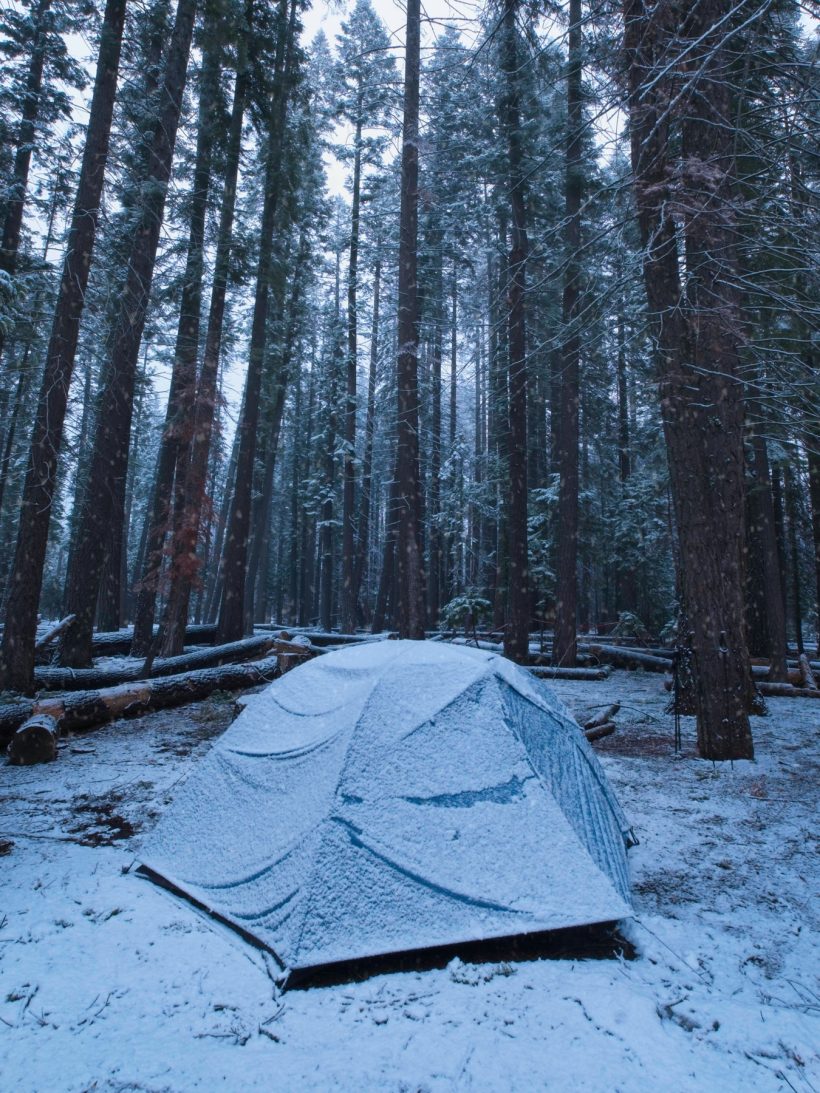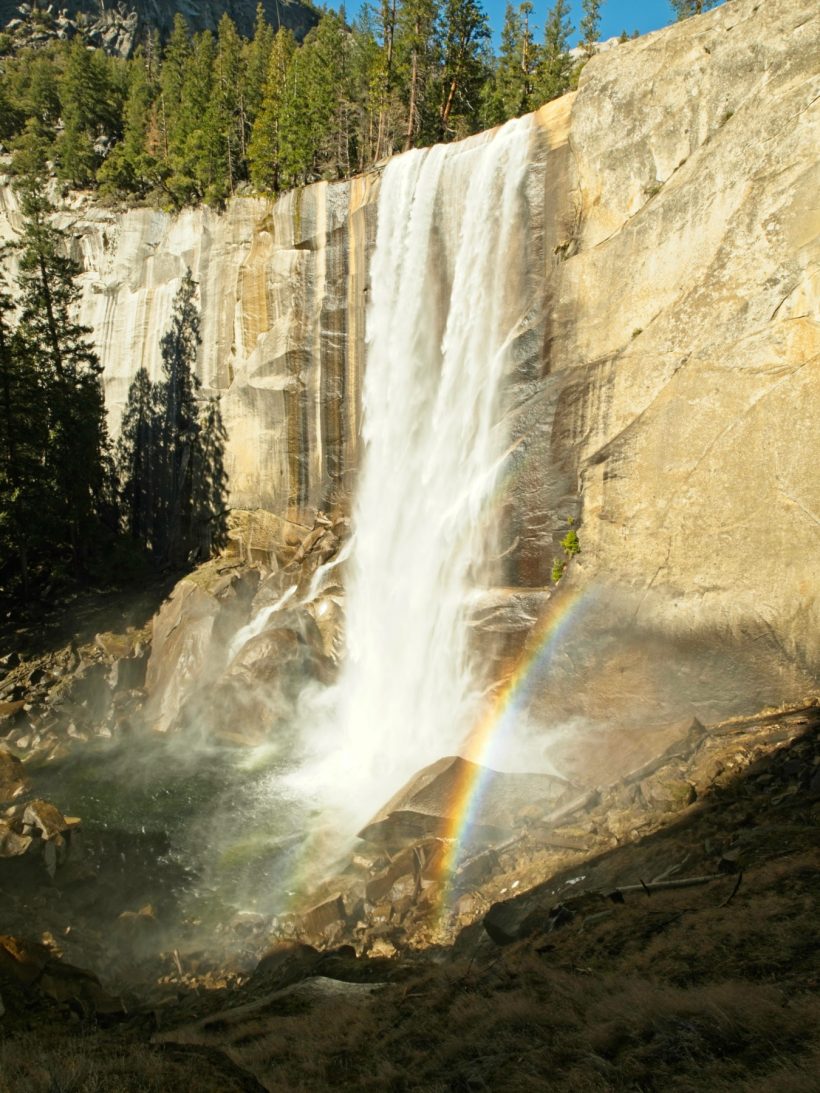I’ve been meaning to visit Yosemite in the winter for some time now. So when gale-force winds cancelled a trip to Mount Shasta that Josh, Kim, and I were planning, I jumped at the chance to see the iconic park covered in snow. Unfortunately, this winter has not been generous in terms of snowfall, but we lucked into a bit of rain and snow on the day we arrived that gave us a little taste of wintertime. Josh planned out a relaxed itinerary for us that includes hikes up to Clouds Rest and Half Dome with overnight stays in Little Yosemite Valley.
Trip Planning
Specs: 25.9 mi | +/- 8600 ft | 3 days, 2 nights
Difficulty: Class 1 with a short stretch of class 2 – 3 on Sub Dome [learn more]
Location: Yosemite National Park | Home of Southern Sierra Miwok and Northern Paiute peoples | View on Map
Route: Follow the bike path from the long-term parking at Curry Village to the start of the John Muir Trail (JMT) and/or Mist Trail. We followed the Mist Trail to the top of Nevada Falls, but there are numerous options here. Continue up the JMT to the Little Yosemite Valley campsite. The hikes up to Clouds Rest and Half Dome begin on the JMT at the campsite and follow well-signed trails.

Permits & Regulations: A wilderness permit (self-issued at the Valley Visitor Center for this trip) is required for all overnight trips, and all of the usual Yosemite backpacking rules (e.g., bear cans are required) apply. Note that, unlike summer months, you cannot camp at a backpackers campground in the valley (it is closed) before you begin your trip.
Resources: The Yosemite backpacking page supplies a wealth of information. Also check out the winter sports and winter wilderness pages for ideas about other winter activities in the park! I carry the National Geographic map for Yosemite whenever I visit; they have several options, including detailed maps for each quadrant of the park and a map set that covers the entire John Muir Trail.
Rainy Day on the Mist Trail
19 Mar 2022 | 4.6 mi | +2300 / -200 ft | View on Map
We pull into the Yosemite Village parking area in a light drizzle; not enough water to soak through clothes, but certainly enough to warrant a rain jacket. We have a few things to take care of, namely securing a permit from the Visitor Center and rearranging gear from suitcases to backpacks. I’m surprised to find that wilderness permits are plentiful and self-issued since they’re booked out months in advance during the summer months.
Once we’ve got the permit and packed our bags, we drive over to the Curry Village parking lot and then walk the bike path to the beginning of the Mist Trail. The start is steeper than I remember and I struggle up the hill under the weight of my fully-packed bag. It’s been months since I last went backpacking, so I’m sure part of the struggle is just re-acquainting myself with carrying all the gear again.
Kim, Josh, and I stop many times on the way up the trail to admire the views (and to rest). Under normal winter conditions, portions of the Mist Trail are closed due to ice accumulation. However, the entire trail is open today so our hike to Little Yosemite Valley is a little shorter than expected and we get to hike right past both Vernal and Nevada Falls. The rain has stopped for now but low-hanging clouds still linger in the canyons, creating some great atmosphere that you don’t often find in Yosemite.
A few hours into our hike, we reach the end of the Mist Trail and pause for a break beside the Merced River just above Nevada Falls. I pull on a jacket to keep the chilly breeze from stealing the body heat built up during the climb and admire the snow-lined riverbanks. The forest is really quite beautiful with the blanket of snow; well worth the colder weather if you ask me!
Following the John Muir Trail, we soon reach Little Yosemite Valley, an established campground surrounded by towering pines just below the imposing southeast face of Half Dome. The campground is more luxurious than I expected; there are bear boxes at every campground and a four-stall composting toilet! If I had known about these amenities, I could have shaved a few pounds from my pack. Oh well. As Josh says, carrying the extra weight all this way “is good training.”
With nightfall approaching, the three of us set up our tents and begin unpacking our overnight gear. We’re just in time too; snow begins to fall soon after we have the tents up. I pull on a few extra layers and then sit down to have dinner with Josh and Kim. Like most meals on the trail, it’s very tasty and I appreciate the hot food even more amidst the falling snow. By the time we finish eating, brushing our teeth, and stashing all our scented items into the bear box, a good half-inch of flakes have accumulated. We stand around talking for a little while, and I snap a few pictures of the campsite, but we soon say goodnight and escape into warm sleeping bags.
Clouds Rest Hike
20 Mar 2022 | 10.4 mi | +/- 3800 ft | View on Map
While falling asleep at 8:30 PM feels amazing, waking up at 4:30 AM does not, particularly when the sun doesn’t rise until 7 AM. I toss and turn for a little while before deciding I need a bathroom break so that I can fall back asleep. I’ve never been more thankful for a latrine in my life than this morning; I do not want to dig a cat hole in the frozen, snow-covered ground. On the walk over to the bathroom, I look up and am happy to see stars – the clouds have cleared, no more precipitation is coming, and it should be a sunny day!
After a couple more fitful hours of sleep I decide I can’t stand being in the tent any longer and get up. The sun hasn’t made it over the eastern mountains yet, but the sky is bright and some of the nearby peaks are beginning to catch the warm morning alpenglow. It looks like it’s going to be a spectacularly beautiful day – every pine tree is blanketed in soft snow, and there’s not a cloud in the sky. I cannot wait to get out hiking!
Once Josh and Kim are up, we eat breakfast together and then prepare for a hike up to Clouds Rest. From our campsite, we’ll hike about 5.2 miles and gain 3800 feet to reach the 9900-foot summit. It’s not a terribly long hike and we’re in no hurry so we don’t begin hiking until about 9:00. I start with all of my layers on to keep out the cold but am soon overheating and have to pause to take a few layers off. My feet take much longer to warm up – maybe 30 minutes? If there’s one thing I’ve learned from winter camping, it’s that the only ways to keep my feet warm are to hike or to get in a sleeping bag. It doesn’t seem to matter what kind of shoes I’m wearing – trail runners, hiking boots, or even mountaineering boots – if it’s cold out and I’m sitting around, my feet are cold.
The hike up to Clouds Rest through the snowy woods is just as spectacular as I hoped it would be. The reds, greens, and browns of the forest really stand out when everything is covered in snow. Kim keeps a lookout for birds as we hike and spots several, including a black-headed woodpecker and several steller’s jays. We’re the first people up here since last night’s snow, so we also find some fresh prints that look like they might be a mountain lion, though they are a little on the small side. (After checking the internet, I now think they were probably coyote or fox prints.)
At the junction between the John Muir Trail and the Clouds Rest Trail we meet two young guys who say they camped up near Clouds Rest last night. They’re on their way down, so we follow their boot prints for the next several miles. The snow grows progressively deeper as we gain altitude, maybe because it was colder up here or maybe because the wind has transported it from other aspects of the mountain. I suspect the latter is at least partially responsible when the young hikers’ prints disappear on a sunny, wind-swept ridge just below The Pinnacles. For the next hour or two, we break trail across untouched snowy slopes, following the occasional hints of a trail: a conspicuous gap between stands of manzanita, cut logs, or an icy remnant of a boot print. After post-holing up to my knee one too many times, we put on gaiters and rest for a few minutes on a bed of exposed pine needles.
Hiking through the deep snow is hard work, particularly when combined with route-finding, but we make it up to Clouds Rest by about 12:30 and spend a few minutes admiring the sweeping views of the snowy Yosemite wilderness. Although I hiked up to Clouds Rest years ago, it was a summer trip and this is my first time getting a view of Yosemite with this much snow. Part of me wants to hike southbound on the JMT right away, to see the whole range in the wintertime. But my cold, wet feet remind me that I am not outfitted for such an rugged adventure.
After gazing out at the mountains for a little while longer, we descend a bit to get out of the wind and enjoy lunch on some sunny rocks. The descent through the deep snow proceeds much quicker and more easily than the ascent. I mean, it’s usually easier to go down than up, but we also have the benefit of our own boot track to follow now and we’ve donned microspikes to help with traction.
By the time we reach the wind-swept ridge where we lost those young hikers’ prints, my feet are thoroughly soggy from the now slushy snow and I’m feeling a bit grumpy about it. I gambled a bit by wearing trail runners – they’re much more comfortable on dry trail than boots, but they don’t keep water out at all – and I’m regretting my choice. However, almost all of the rest of the descent is on dry ground. The pristine blanket of snow we marveled at this morning is almost completely gone! So by the time we reach camp later in the afternoon, my socks and shoes are considerably drier and I feel much happier.
With several hours of daylight left, Kim, Josh, and I spend some time playing avalanche transceiver hide-and-seek. We’ve all recently taken an avalanche preparedness course and have new transceivers that we need to learn about and practice with. So we take turns searching for a hidden transceiver; it’s a fun game, definitely a good way to get familiar with a new device!
We spend the rest of the afternoon lounging around camp. I go barefoot for a while to let my feet dry out after spending the day in soggy socks, which feels amazing but has the distinct downside of coating the bottoms of my feet in pine sap. I particularly enjoy dinner tonight (cheesy rice and beans with fritos!) after all the hiking and am happy to crawl into bed once the sun has set.
Half Dome Attempt
21 Mar 2022 | 10.9 mi | + 2500 / -4600 ft | View on Map
In the wintertime, the cables between the foot and summit of Half Dome are “down,” i.e., the poles and wooden steps that keep the cables suspended above the granite are removed. For most hikers, this means Half Dome is a no-go. But if you’re experienced with rock climbing and friction hitches, you can safely summit by tying into the cables. Yesterday morning, a couple that attempted to summit informed us that the cables are still buried under snow and ice. But with all the sunshine and warm temperatures, we want to hike up and see for ourselves.
Unlike yesterday’s hike to Clouds Rest, the first few miles of the hike up to Half Dome are snow-free. It feels more like a summer hike than a winter one! We do eventually reach consistent snow cover and pull out microspikes to avoid slipping on the icy crust. I’m a little nervous about “Sub Dome,” a smaller granite dome that we have to climb to reach the base of the cables. From here (and from Clouds Rest yesterday), the face appears nearly vertical and is covered in snow. If memory serves, the trail cuts into the steep granite and I imagine it’s almost completely covered right now. However, as is usually the case, the slope is much less steep than it appears from a distance. Josh leads the way up the dome, carefully following the compressed footsteps of earlier hikers. My microspikes hold about 95% of the time, but occasionally slip as the snow crumbles underfoot. Needless to say, it’s not a terribly comfortable climb and I’m very glad to reach shallower grades at the top of sub dome.
When we arrive at the foot of the cables we find two gentlemen we met in camp preparing to climb the cables. As reported yesterday, there are still several distinct patches of snow and ice that completely cover the cables. The men are hoping the snow is soft enough to pull or dig the cables out as they go, so we make ourselves comfortable on the sunny rocks and wait for them to make their attempt.
The two climbers are able to easily pull the cables from the lowest snow patches, but cannot extract them from a larger patch about 30 feet up the slope. Josh, Kim, and I discuss options while we watch. If we had a rope, I would suggest building an anchor at the base of the snow patch, and then lead climb up the snow/ice to where the cables appear again. Another anchor at the top would allow the leader to belay for the followers and then they could continue up the cables as before. Of course, we don’t have a rope; we don’t even have enough slings that we could tie together to form a static line. We also don’t really have the gear to build an anchor besides a few prusiks.
The climbers seem to have a similar discussion up on the rock and ultimately decide to free-solo the snow. In other words, they (in turns) untie from the cables and scramble their way up the snow and ice to where they can retie into the cables. The first climber slips a few times on his way up, which makes me extremely nervous. The snow seems to be warming, and all he’s got are microspikes; crampons might hold, but the whole slab of snow could slide on the polished granite slabs… Thankfully, he makes it up without falling and his buddy follows suit. They continue up the slabs to a higher snow patch but ultimately decide not to try the same trick there. The slope is steeper, and they have no way to arrest their fall if they slip besides grabbing one another. We wait for them to descend below the first snow field they soloed and then head out ourselves; we do not have the gear required to protect this climb.
Rather than descend the steep snow on the face of Sub Dome, we scramble down a series of class 2 – 3 granite slabs. The rock provides much more stability than the quickly softening snow since I’m not at all confident that my microspikes will hold in these conditions (they’re for ice, after all). We pause for a leisurely lunch break on the way down and greet a smattering of hikers on their way up to Half Dome.
Back at camp, we pack up our overnight gear and then hike down to Nevada Falls. The Mist Trail is much busier today than it was when we hiked in, probably because the weather is much nicer today. In fact, it’s downright warm! After passing many, many hikers, we reach Vernal Falls where the bright sunshine creates some stunning rainbows. Just a short time later, we arrive at level ground in Yosemite Valley and walk back to the parking lot. What started out as a winter trip now feels like an early summer outing, but I’m not complaining. It’s been a beautiful weekend in Yosemite National Park!






























Craig Barlow 30 March 2022
Nice report, it really is amazing how fast that snow melts! Also, good job on not doing anything stupid on Half Dome…
Andrew 4 April 2022 — Post Author
Thanks Craig!